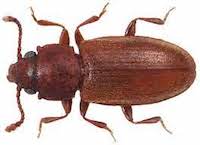WHAT DO foreign grain BEETLES LOOK LIKE

Foreign grain beetles, Ahasverus advena (Coleotpera: Silvanidae), are a very small, flattened insect, about 1/12 inch long and reddish-brown in color. Under magnification, it can be identified by two peg-like projections on the pronotum directly behind each eye. They’re strong fliers and can be confused with fruit flies or gnats due to their small size. They also are associated with moist, humid conditions like those fly species. However, foreign grain beetles have a hard shell compared to flies and their wings fold under their hard wing covers (elytra) when at rest making them difficult to see. They can also be mistaken for fleas or lice but neither of these insects have wings. Foreign grain beetles produce large numbers of offspring in a short amount of time and infestations can often appear overwhelming by the time they are noticed. They can complete their life cycle in about 30 days, but should the humidity fall below 58%, they will lose their food source (fungi and molds) and the populations will subside.